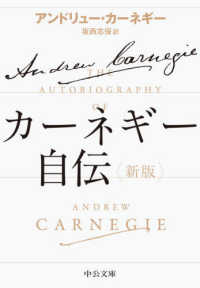- ホーム
- > 洋書
- > 英文書
- > History / World
基本説明
中国自身から見た決定版中華文明史を全訳。2006年に北京大学出版局から刊行された、北京大学国学研究院編纂の権威ある全4巻。中華文明の発祥から1911年の辛亥革命までが対象。政治、社会、経済、宗教、哲学、科学技術、文学、芸術、日常生活にいたるまで、新たな研究成果を豊富に盛り込んで徹底解説。訳者による新たな序文を各巻に付し、西洋の中国学の視点を補う。
Full Description
Written by scholars at Peking University, this is a history of Chinese civilisation in its totality, from Neolithic times to the founding of the Chinese Republic in 1911. Each of the four volumes covers political and social institutions, economics, religion, philosophy, science and technology, literature, art and daily life. There is no other work in the English language that covers this range of subjects in a single history. These volumes make accessible a wealth of historical research and sources that have not previously been translated, and provide insights into the views of the foremost Chinese scholars of their generation. These views are placed in context by newly commissioned introductions to each volume, and discussion throughout is supported by illustrations sourced from collections around the world. This ambitious and inspiring work will stimulate fresh debate across the humanities and social sciences, opening new avenues of academic exchange between East and West.
Contents
Volume I. Earliest Times - 221 BCE: Preface; General introduction; Introduction; 1. The dawn of Chinese civilization; 2. The beginnings of Chinese civilization; 3. The flourishing of civilization in the Shang and Zhou; 4. Brilliant bronze culture; 5. The application and production of bronze; 6. Capitals, cities and commerce of the Shang and Zhou; 7. The origins and early development of Chinese script; 8. Religion and belief in the Shang and Zhou periods; 9. The development of education and the flourishing of scholarship; 10. The birth of Chinese literature and art. Volume II. Qin, Han, Wei, Jin, and the Northern and Southern Dynasties: Preface; Introduction; 1. Creation and development of a multiethnic centralized state; 2. The establishment and transformation of bureaucratic government; 3. Growth of the feudal economy; 4. The position and evolution of Ruist learning; 5. Abtruse learning in the Wei and Jin dynasties; 6. The introduction of Buddhism and the appearance of Daoism; 7. The foundation and development of historiography and geography; 8. Literature of the Qin, Han, Wei and Northern and Southern dynasties; 9. The full flourishing of the Arts; 10. Systemization of science and technology; 11. Social life. Volume III. Sui and Tang to mid-Ming Dynasties (581-1525): Preface; Introduction; 1. Fusion of southern and northern cultures and unification of the empire; 2. The silk road and cultural exchange between China and foreign lands; 3. Economic prosperity and the shift of the economic center of gravity to the south; 4. The development of the civil service examination system and the rise of the new literati class; 5. The perfection of the civil official system; 6. Ruism and new developments in religion; 7. The expansion of scholarship and the florescence of education; 8. The evolution of the northern peoples and their contribution to Chinese civilization; 9. A new period in the history of Chinese-foreign relations; 10. Science and technology and the development of the concept of science; 11. The downward movement of literature and its full florescence; 12. Artistic style and the spirit of the times; 13. Social life. Volume IV. Late Ming and Qing Dynasties (1525-1911): Preface; Introduction; 1. Economic development; 2. Proto-enlightenment trends and new elements in political culture; 3. Science and technology; 4. The establishment and growth of a multiethnic state; 5. Political development and people's livelihood; 6. Cultural awareness and achievement in the early and mid-Qing dynasty; 7. The eastward flow of western learning and the spread of Chinese civilization; 8. Religious belief: concepts and practice; 9. New directions in literature and the arts; 10. Order and disruption in social life; 11. Education in schools and in society; 12. The building of core cities and the emergence of regional differences; 13. The push for reform: the birth of modern culture.






